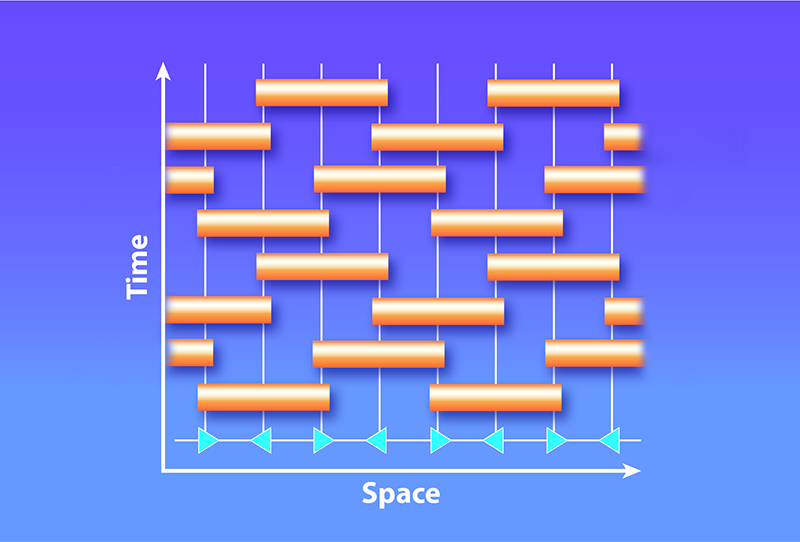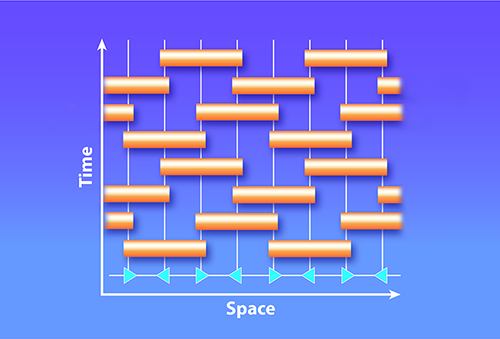Making Quantum Dynamics Exact
The concept of thermodynamics is nearing its 175th birthday. Despite the longevity of the field, many thermodynamics-related questions remain unanswered. One of those questions is exactly how the laws of thermodynamics emerge in a many-body, quantum system. Another is how to characterize chaos in that same system. Both problems involve understanding how quantum entanglement evolves in a complex quantum system, something that has been hard to study because solving the models used to describe such systems is numerically costly in time and computing power. Now, three research groups present theoretical advances that help circumvent that challenge by providing analytical descriptions and exact solutions for various aspects of thermodynamics and of chaos in these quantum systems [1–3].
The new studies all consider quantum many-body systems, which are systems that contain a large number of interacting particles. These particles all obey the laws of quantum mechanics and their repeated interactions give rise to quantum correlations and quantum entanglement in the system. The systems also all obey the laws of thermodynamics.
The second law of thermodynamics states that when an isolated quantum many-body system is “quenched,” such that it is driven out of equilibrium, the system’s state will evolve over time to reach a state of thermal equilibrium and maximum entropy. An exact description of this so-called thermalization process is challenging because of several complicating factors. One factor is the huge number of degrees of freedom in interacting quantum many-body systems, which can make models intractable. Another factor is that the parameters describing the system’s entanglement and correlations change over time. These two factors typically limit analyses to small quantum systems and short evolution times, but even for these cases the studies are still extremely demanding.
A third complicating factor is chaos, which in quantum many-body systems manifests as nonlocal propagation of quantum information. The presence of chaos adds an additional layer of complexity to models, but it can also allow for some simplifications. For example, in a chaotic classical system, researchers can ignore the individual motions of particles and can instead describe the system using macroscopic features, such as temperature and specific heat, provided by thermodynamics. Chaos is also intrinsically linked to thermodynamics through a quantum system’s entanglement dynamics. That means that models that describe the dynamics of quantum many-body systems can also describe their thermodynamic and chaotic properties.
Previously developed methods address some of the above-mentioned complications, allowing the modeling of larger systems and longer evolution times, but those methods involve approximations that can limit accuracy. Researchers are thus developing alternative methods. One promising approach involves interpreting the system as a series of quantum circuits. These circuits approximate the time-evolving dynamics of the quantum system with gates and wires. The gates perform unitary transformations on the system’s state, and the wires are used to represent the passage of time. Quantum-circuit models are highly simplified models, but they still retain most of the essential physics of the complex phenomena. The three new studies all use this approach, although they work with distinct circuits and consider different aspects of the problem.
The first of the studies, which was carried out by Pieter Claeys and Austen Lamacraft of the University of Cambridge, UK, uses quantum circuits to predict the evolution of quantum correlations in a many-body system—something that is relevant to both thermodynamics and chaos [2]. Specifically, the duo demonstrates a method for generating so-called dual-unitary circuits—ones whose quantum correlations can be explicitly obtained in space and time [4]. They consider systems with arbitrary dimensions of the Hilbert space, which encloses all possible quantum-mechanical states of a given system. They show that their approach leads to analytically tractable solutions for any level of ergodicity, a property that relates to the decay of the correlations in the system.
In the second study, Katja Klobas of the University of Oxford, UK, and colleagues use quantum circuits to probe the thermalization of quantum many-body systems [1]. They consider a specific kind of circuit known as Rule 54. These circuits are made of chains of qubits and, as other studies have demonstrated, their properties are exactly solvable. The team quenches the system and then monitors the post-quench dynamics using so-called tensor network methods [5]. They show that their approach enables a full and exact description of the thermalization process, and they find exact predictions for the asymptotic growth in a set of parameters known as the Rényi entropies, which are often used in quantum information to measure the degree of entanglement in a system.
Like the Oxford study, the third investigation involves Rényi entropies. Zongping Gong and colleagues at the Max Planck Institute of Quantum Optics, Germany, study the evolution of these entropies in a quantum circuit known as a quantum cellular automaton [3]. This circuit has a topological index that is thought to characterize its ability to transport quantum information [6]. This index can be obtained mathematically, but the calculated index typically lacks an explicit physical interpretation. Gong and colleagues instead obtain the index using Rényi entropies, which are experimentally measurable [7] and, in doing so, confirm the quantum information interpretation of the index. The team also places a lower bound on the entanglement entropy of its quantum circuit, which is equal to twice the topological index, and interprets it as a lower bound on the rate of growth of quantum chaos.
Together, these three studies offer remarkable advances for predicting nonequilibrium dynamics in isolated, interacting quantum many-body systems. But they are not the end of the journey. For further progress, it is crucial that researchers develop methods and approaches that can explore other aspects of dynamics and that can link in with state-of-the-art ultracold atom experiments. In particular, a deeper understanding of the timescales of the nonequilibrium dynamics is needed to reveal any nontrivial features. This issue is relevant from a fundamental point of view for condensed-matter physics but is also essential for the development of future technologies, such as quantum computers, which in some cases use quantum circuits to perform quantum simulations [8].
References
- K. Klobas et al., “Exact thermalization dynamics in the ‘Rule 54’ quantum cellular automaton,” Phys. Rev. Lett. 126, 160602 (2021).
- P. W. Claeys and A. Lamacraft, “Ergodic and nonergodic dual-unitary quantum circuits with arbitrary local Hilbert space dimension,” Phys. Rev. Lett. 126, 100603 (2021).
- Z. Gong et al., “Topological lower bound on quantum chaos by entanglement growth,” Phys. Rev. Lett. 126, 160601 (2021).
- B. Bertini et al., “Exact correlation functions for dual-unitary lattice models in 1+1 dimensions,” Phys. Rev. Lett. 123, 210601 (2019).
- M. C. Bañuls et al., “Matrix product states for dynamical simulation of infinite chains,” Phys. Rev. Lett. 102, 240603 (2009).
- D. Gross et al., “Index theory of one dimensional quantum walks and cellular automata,” Comm. Math. Phys. 310, 419 (2012).
- R. Islam et al., “Measuring entanglement entropy in a quantum many-body system,” Nature 528, 77 (2015).
- F. Arute et al., “Quantum supremacy using a programmable superconducting processor,” Nature 574, 505 (2019).





